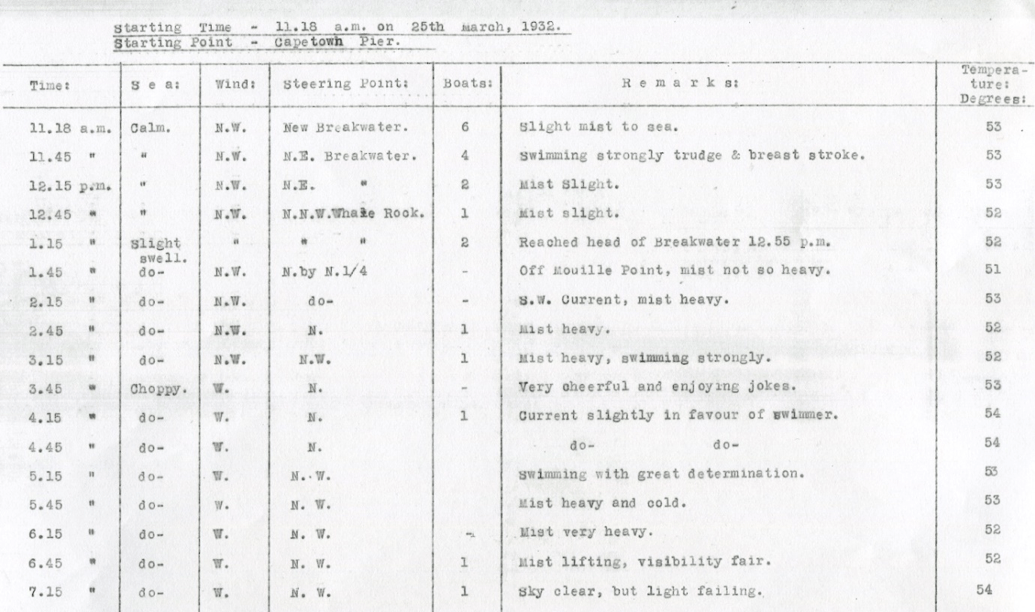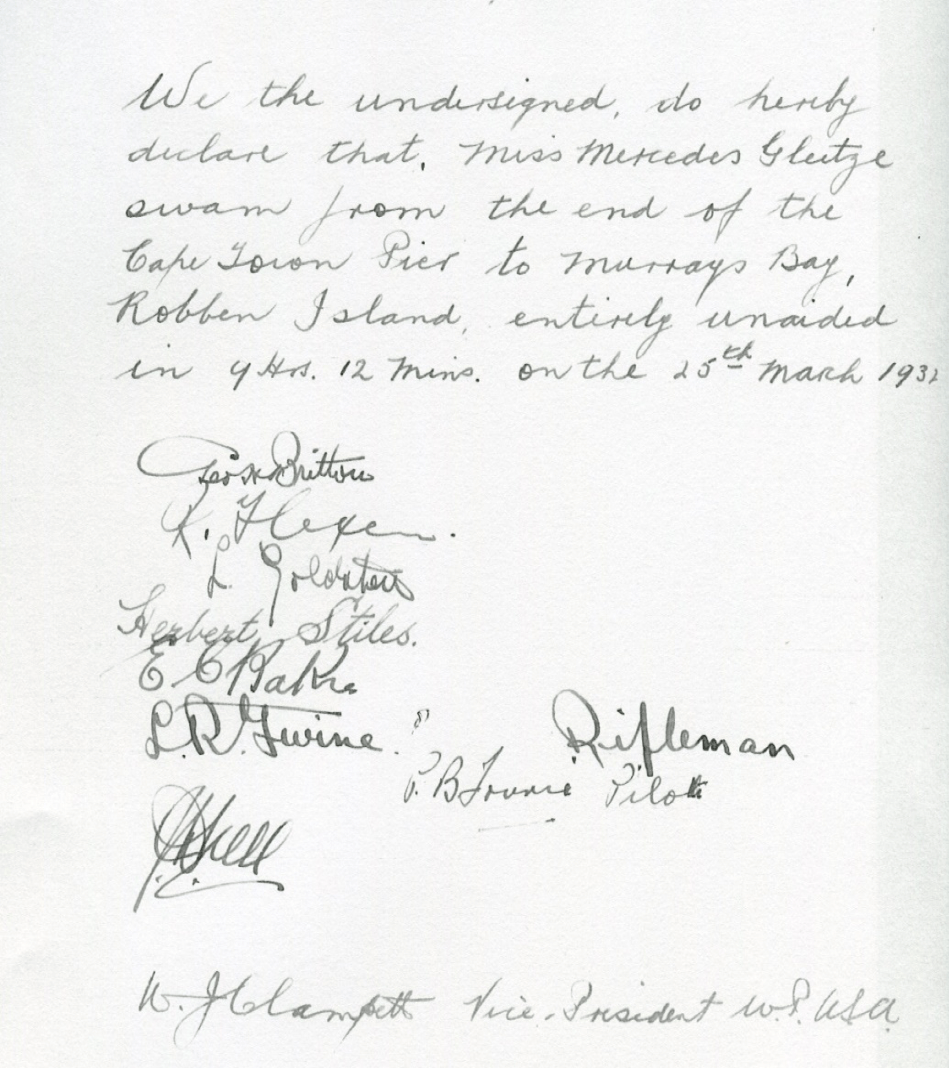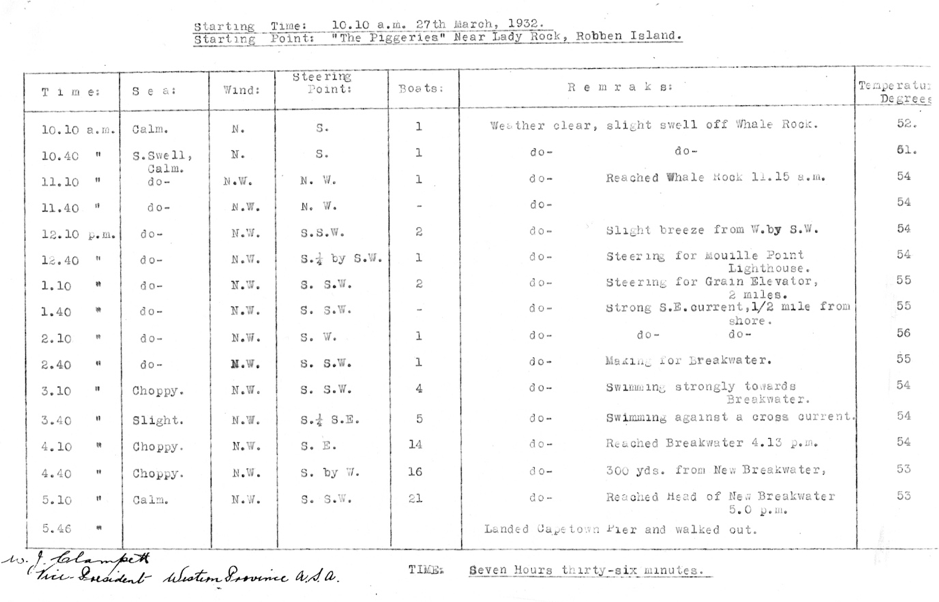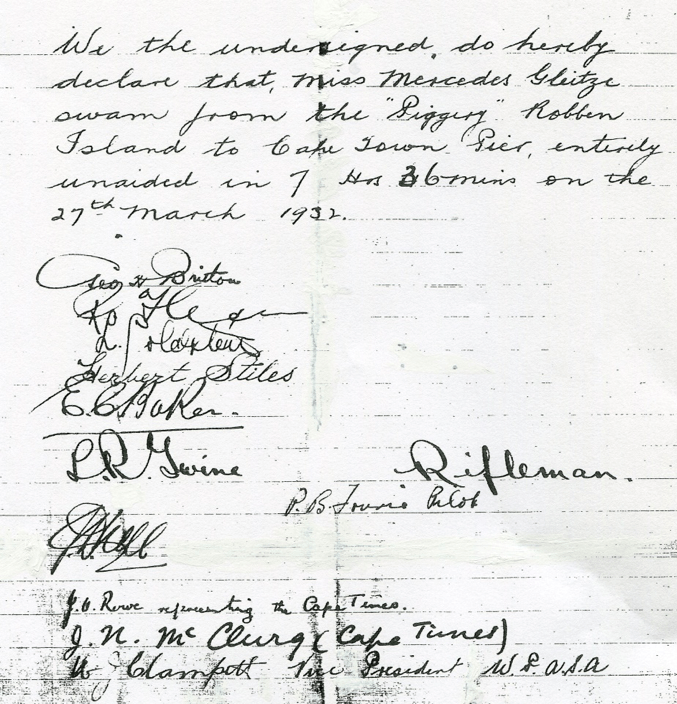CAPE TOWN TO ROBBEN ISLAND (25 March 1932)
- AND BACK (27 March 1932)
Organisers:
Mr A.S. Morris of the Long Street Baths; Sergeant Fourie of the Docks Police.
Official pilot boat:
The Flora
Skipper of accompanying pleasure trip yacht:
Captain Cruickshanks (motor yacht: The Chance)
In row boat:
Oarsman, and Sergeant Fourie (rifleman)
Official witnesses:
Officials from the West Peninsular Amateur Swimming Association
Hosts on Robben Island:
Mr Small (the lighthouse keeper), his wife, and Mr and Mrs Morrison.
In the 24 and 27 March 1932 editions of the Cape Times, both crossings were covered in detail, and a précis follows:
Outward Bound (25 March 1932)It was an ambitious undertaking and the conditions would not be pleasant. Despite South Africa’s geographical position, the waters around Cape Town are surprisingly cold. In one of her attempted swims across the Irish Sea Mercedes had spent over ten hours in waters the temperature of which was on average 48ºF. She was informed that in some parts of Table Bay she may find the water even colder than that. However it was estimated that hopefully the average temperature was not likely to be much below 55ºF. There would also be the currents to contend with, and a surprisingly heavy sea swell not noticeable until one is well on the way to the island. Much would depend on the pilot in his choice of the right course.Mr A.S. Morris of the Long Street Baths and Sergeant Fourie of the Docks Police were in charge of the organisation, and officials from the West Peninsular Amateur Swimming Association were present to certify the swim.Arrangements were made for Mercedes to be accompanied by a rowing boat and a motor launch, The Flora, and in addition the motor yacht The Chance would offer two-hourly trips “to give Capetonians an opportunity of seeing the methods and customs of that curious genus, the Channel swimmer”.Mercedes planned to spend the night on Robben Island after the initial crossing from Cape Town on Friday, the 25 March 1932, and start the return journey at 6 a.m. the following morning, hoping to reach the Cape Town pierhead between 3 p.m. and 4 p.m. in the afternoon.The start of the first lap from the pierhead was delayed for one hour and 20 minutes to allow the fog to clear. When she emerged from the cabin of The Chance, greased with oil, to start the swim, the Cape Times reported that she was greeted with rousing cheers.When she waded into the water at 11.18 a.m. the temperature was 50ºF. She wore a mosquito net over her head and face for protection from salt spray and to prevent possible sunburn. She began her swim with an easy arm crawl and the ordinary breast stroke kick. She had not gone very far, however, when the fog again settled in and enshrouded her. A bitingly cold wind made conditions all the more difficult. The siren at the breakwater and the fog horn at Robben Island sounded continually. At 12.10 p.m., after reaching the corner of the Mole, she was given her first nourishment – some hot beef tea. She was fed thereafter at half hourly intervals with hot soup and other beverages.When she was clear of the breakwater she swam north-north-west because of a cross-current. The route chosen was extremely difficult. There is apparently no sensible tidal stream between Rogge Bay and the Island. A current varying in strength from half a knot to two or three knots sets to the northward past Table Bay and Robben Island. It helped Mercedes a little that, after midday, the temperature rose from 50ºF to 52ºF. She changed her stroke at regular intervals from crawl to breaststroke in order to ease her muscles. The official motor launch was plotting her course by compass. At 2.45 p.m. it was found impossible for Mercedes to follow the set of the compass, but Captain Cruickshanks (skipper of The Chance motor yacht) intervened and put them on the correct course. At 4.30 p.m. she was still swimming strongly but the weather conditions deteriorated. The fog had increased in density and this was followed by a heavy drizzle.Fearing that Mercedes and the accompanying boats would go off course and drift past the Island with the current, Captain Cruickshanks hurried to her assistance in The Chance. It took him one hour and ten minutes to locate Mercedes, who had once again gone off her course. Darkness was approaching, and fearing that the rowing boat, the motor launch and the swimmer were lost, Captain Cruickshanks fired rockets from the mast of The Chance. No reply was received, and he stopped the engine of his yacht to listen for shots from the rowing boat. Thankfully, a few minutes later shots were heard and Mercedes and the rowing boat were located at 6.05 p.m.The swimmer was found to be accompanied only by the rowing boat – The Flora launch having gone to Robben Island to refuel. Mercedes had been steering a wrong course, but was still swimming strongly. She was then about a mile and a half from the island and the roughest passage was still ahead. At that stage she was covering just over one mile per hour, and although feeling the cold intensely after six and a half hours in freezing conditions, she refused to abandon the attempt. She relayed a message to Captain Cruickshanks saying that she would only leave the water if he thought it impossible for her to complete the swim. She followed this with a second message asking the Captain if he would stand by her until the end of the swim.There were over 120 passengers aboard The Chance, who were expecting to return to Cape Town pierhead at 6 p.m. Among them were a number of infants and school children. Captain Cruickshanks explained to them that unless they were willing to remain at sea Miss Gleitze might be compelled to give up the swim. A unanimous shout of “We’ll stay, let her carry on.” followed this announcement. When the news was conveyed to Mercedes, who had been treading water for about 15 minutes, she lifted the net from her face in appreciation and continued her swim at a very powerful pace. Her action was greeted with loud applause.The Chance kept alongside at a dead slow pace and the passengers aboard kept up a continuous refrain of old-time melodies to cheer and encourage the swimmer. Shortly after 7 o’clock, when darkness had set in, the fog cleared slightly and the dim outline of Robben Island was sighted for the first time that day. She was then a mile and a quarter from the shore and swimming powerfully.At 7.45 p.m. the official motor launch (The Flora) returned from the Island. All the lamps of The Chance were now alight, and when the crowd aboard paused in their refrain, jazz music was played on the gramophone. At 8 p.m. the launch ran short of petrol again and fell behind. About half a mile from the shore Captain Cruickshanks provided the rowing boat with a lighted lamp.At 8.30 p.m. Mercedes walked unaided out of the water on to Murray Bay on Robben Island – the first half of the double swim completed. A bonfire was lighted ashore to signal her arrival, and three hearty cheers were given by the passengers and crew aboard The Chance. She then walked from the shore to where the lighthouse keeper’s motor car waited to take her to his home. She told friends who had been waiting at Murray Bay to greet her, that she was feeling very fit but had been extremely cold. At Mr Small’s home she was given a meal of chicken, bacon, eggs and coffee, and after chatting to her friends for a few minutes she went to bed and was asleep by 10 p.m.
Mercedes had completed the outgoing stage in nine hours and twelve minutes. It was the first time the crossing in that direction had been conquered. The swimming authorities stated that her achievement was remarkable, and that the swim was the hardest that had ever been attempted in South Africa. The temperature of the water throughout averaged 50ºF, and fog and a bitingly cold wind made conditions worse. She told a representative of the Cape Times that as she was nearing Robben Island the weather conditions were foul, and that she had always loathed the fog. She found the different currents very distressing, but realising that she was near the end of the swim, she knew she was going to win through.
Although Sergeant Fourie, who accompanied Mercedes in the rowing boat, carried a loaded rifle ready in case sharks were lurking in the water, none was seen, but there were several false alarms. There were a few seals around, but these gentle, friendly sea creatures had been her companions on other swims, and she rather liked them being there. As it happened, she was very fortunate. She was later informed that three weeks after her swim two giant sharks (11 feet long) had been seen in the bay.
The return swim (27 March 1932)During the outgoing swim, Mercedes was bitten badly by bluebottle jellyfish (Physalia physalis) and the following morning, because the venomous stings had made her feverish, it was decided that she should postpone the planned return swim to Cape Town until Sunday, to allow 24 hours for her temperature to come down.The lighthouse keeper, Mr Small, his wife, and a Mr and Mrs Morrison, took care of her. Later on, when she was up and about, Mr Small took Mercedes and her husband for a drive around the island and showed them the deserted leper settlement. She said the enforced interlude on the island was very interesting and enjoyable.The swim back to Cape Town on Sunday was, as Mercedes described it, a pleasure, and uneventful when compared to the challenges she had faced on Friday. Except for one stretch, she enjoyed every mile of the homeward course, and said it was one of the easiest she had undertaken.She left at 10.10 a.m., two hours later than planned. There was a thick band of fog in the early hours of the morning, and at 8 eight o’clock it was feared that the attempt would have to be abandoned. However, word came from Cape Town that the fog was lifting fast, and by 9.30 a.m. Table Mountain was visible from the island.The course was set on a line from Whale Rock to a point on the Sea Point coast. Mercedes was taken down to the starting place in the lighthouse keeper’s motor car, accompanied by most of the island’s inhabitants. The surf was too rough at the suggested place of departure, and the start was delayed again until a suitable spot [The Piggeries] was found near Lady’s Rock, about 300 yards from the Robben Island jetty.When she entered the water it was icy, but after thirty minutes or so, although the temperature was a chilly 52ºF, her body began to acclimatise and she felt more comfortable. However, she had to fight against currents soon after she left the island, and again before she reached the breakwater at the pier. The fight against these currents tired her and retarded her progress. At one stage she hardly made any headway for an hour. “It is all a matter of will power to conquer the currents and not let them conquer you”, she said when interviewed after her swim. Although she only had to struggle with the currents on two occasions on this homeward leg, having to swim across them exhausted her.About 11 a.m. Captain Cruickshanks’ pleasure boat, The Chance, arrived once more on the scene carrying another boatload of spectators who cheered her on. She was fed at regular intervals with soup and other beverages, and she also managed to eat some chicken and bread. Unlike on Friday, she swam a true course, and at 11.20 a.m. she passed Whale Rock. After she had been in the water for two hours, Sergeant Fourie announced that she had covered three miles. At her request music was played on the gramophone, and those on the three accompanying boats sang to her across the water. At 12.30 p.m. she was one and a quarter miles off the mainland. Her course was then set for Mouille Point. By 1.10 p.m. she had covered four miles. Hired fishing boats and yachts had already begun to follow the progress of the swim, and the hearty refrains of their crews and passengers greatly encouraged her.At 2.30 p.m. her course was changed towards the breakwater. Shortly afterwards, The Chance arrived with another huge crowd of passengers who began singing in competition with the officials aboard the motor launch. Her acknowledgement met with rousing applause.At this stage Mercedes experienced the most difficult part of the course. At 3.15 p.m., swimming close inland, she was within 440 yards of the breakwater. A stiff breeze had risen and a severe cross-current was running. Mirrors flashing semaphore messages were seen from different points on Devil’s Peak and Signal Hill. She was cheered for the rest of the swim towards the pier by the crowds in the boats and on the shore. She removed the net from her head and kept a smiling face to the applause of the onlookers. The dinghies and rowing boats following her caused some difficulty to her progress, but when it was suggested that they should distance themselves, she interrupted with: “I am used to the boats, don’t send them away.”When she rounded the corner of the Mole she momentarily changed her breaststroke for an overarm crawl – the first time she had varied her stroke on this leg of the swim. Numbers of rowing boats from the pier, together with yachts and motor launches, surrounded her and she was spurred on by almost frantic community singing.By this time, hundreds of people had swarmed down to the breakwater to see the finishing stages of the swim. It was reported that they were not disappointed and were able to watch one of the most thrilling battles ever seen in the Cape peninsula waters. Mercedes had to fight the currents for more than an hour, but her dogged perseverance and moral courage won the battle. As she neared the breakwater the cheers of the crowd on the shore and in the boats resounded for miles around.She passed the breakwater at 5 p.m. and when within 15 yards of the pier she made a final overarm sprint, which was met with thunderous cheers from the crowd of more than 3,000 who had thronged there to see her. It was reported that there was a stampede towards the steps when she first touched the concrete, but officials barricaded the area and allowed her to escape to the dressing room.
Mercedes had completed the outward journey in a time of 9 hours and 12 minutes, and the homeward swim in a time of 7 hours and 36 minutes – claiming a new record of being the first person to cross from Cape Town to Robben Island, and also the first person to achieve the double swim. Asked later whether she thought she could improve on the excellent times she had achieved on both crossings, she said that she was not out to create speed records, but was merely concerned with getting to her destination.
Swimming log, Cape Town to Robben Island


Witness Statement, Cape Town to Robben Island

Swimming log, Robben Island to Cape Town

Witness Statements, Robben Island to Cape Town
